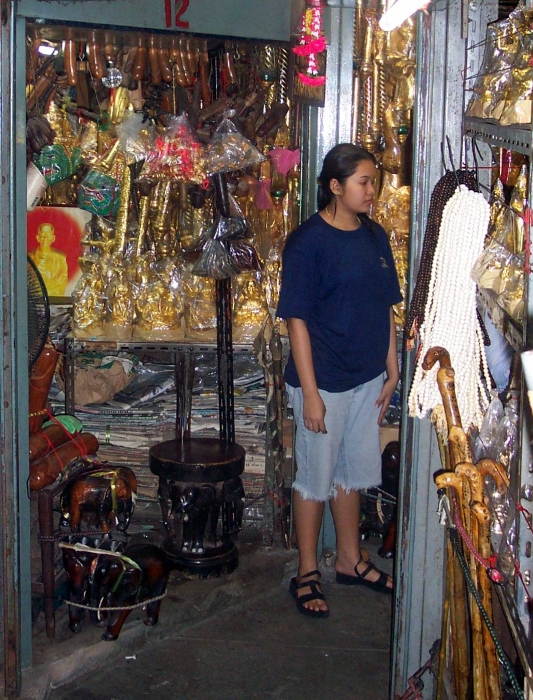Just inside the north-east entrance to the old city precincts, on the city's "main street" Ratchadamnoen Road, is the temple of Wat Ratchanadda. In this temple is one of the most unique temple structures in Bangkok: the Loha Prasat ("metal castle"). The prasat appears almost Burmese in design, although in fact it's a copy of an old style of Buddhist structure found in Sri Lanka, but now almost unknown. It was begun in the early nineteenth century by Rama III, but only recently completed.
The prasat itself is like five concentric square towers, each consecutively taller than the other. The outer, middle and center towers are capped by cast iron spires, which gives the temple its name. The two interstitial towers are capped by open walk-ways lined with shrines. Visitors to the prasat are requested to make a 20 Baht (0.52 USD) in box just inside the entrance gate at the base of the structure.

The Loha Prasat
At the ground level the thick laterite columns supporting the towers form an almost maze-like collection of corridors. Although you're always within sight of the outside, it's worth taking a little time to get lost in the corridors on your way to the massive spiral stairway up the center tower. In late 2007, an installation describing the history of the structure was put on display in some of the corridors. All of the text is in Thai, but there are plenty of pictures.

Cast iron spires of the prasat.
The staircase is constructed as a free-standing metal center column with thick wood treads cantilevered off it. You can choose to climb all five stories at once or get off at any level to explore. The stairway actually ends on the roof of the fourth tower. Here there is an outside walkway from which you can see the Golden Mount across the street, as well as the park in front of the temple. From the walkway you can climb one last stairway to view the shrine at the top of the temple.

Lucky charms in the amulet market.
Aside from the Loha Prasat the other main attraction to Wat Ratchanadda is the amulet market which extends behind the temple. The market is very popular, but is one of the more expensive places to buy an amulet. In years past, the market was also one of the best places to see bhalik charms in all their forms, but now there are only a few shops which carry these phallic shaped pieces of wood thought to help accumulate wealth.
If you continue through the market and out the back, you'll find a continuation of the market, with stalls crowded in around the ruins of an old temple building. There's no information about what this building was, but it was restored recently and the bas relief sculpture on the one wall still standing was painted.
Getting There
You can take it with you.
Wish you could have this information with you when you visit the Loha Prasat? Now you can. Check out our downloadable eGuides.
Getting to the Loha Prasat and Golden Mount can be a bit difficult. It is not close to any tourist-friendly transportation, such as the Skytrain or river boat. The best option is to get a taxi from your hotel. That can sometimes be a bit difficult, so you can also try taking the Chaophraya Express Boat to the Memorial Bridge pier, then take a taxi or tuk-tuk from there.
There's a lot to see in the area around the temple. See the Golden Mount area map for more ideas. The Loha Prasat is part of our walking tour of the eastern wall of old Bangkok.